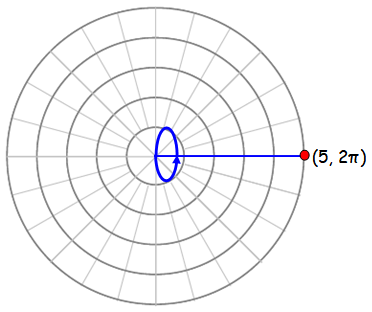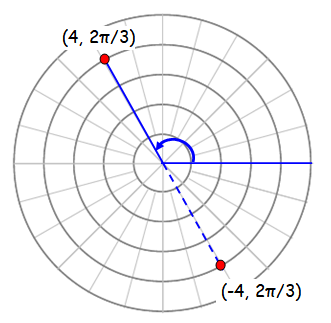HOW TO PLOT POLAR COORDINATES
The polar coordinates will be in the form (r, θ). Here r is directed distance.
In other words (r, θ) can be defined where the radius intersects the angle.
r is the distance from the origin to the point and θ is the angle of rotation from positive x axis
As in trigonometry, we measure θ as positive when moving anticlockwise and negative when moving clockwise.
If r > 0, then P is on the terminal side of θ. If r < 0 then P is on the terminal side of π + θ.
Example :
Plot each point
(a) (2, π/4) (b) (3, 5π/6)
(c) (-5, π/3) (d) (4, π/2)
(e) (5, 2π) (f) (-4, 2π/3)
(g) (-1, -5π/4) (h) (2, -4π/3)
Solution :
(a) (2, π/4)
r = 2 > 0 and θ is positive, so we should move anticlock wise direction.

(b) (3, 5π/6)
r = 3 > 0 and θ is positive, so we should move anticlock wise direction.

(c) (-5, π/3)
r = -5 < 0 and θ is positive, so we should move anticlock wise direction.
To plot a point with
a negative radius,
find the terminal
side of the angle
but then measure
from the pole in
the negative
direction of the
terminal side.

(d) (4, π/2)
r = 4 > 0 and θ is positive, so we should move anticlock wise direction.

(e) (5, 2π)
r = 5 > 0 and θ is positive, so we should move anticlock wise direction.

(f) (-4, 2π/3)
r = -4 < 0 and θ is positive, so we should move anticlock wise direction.
Since it is negative radius, the terminal side is at (π+2π/3)

(g) (-1, -5π/4)

Kindly mail your feedback to v4formath@gmail.com
We always appreciate your feedback.
©All rights reserved. onlinemath4all.com
Recent Articles
-
Digital SAT Math Problems and Solutions (Part - 150)
Apr 25, 25 11:46 AM
Digital SAT Math Problems and Solutions (Part - 150) -
AP Calculus AB Problems with Solutions (Part - 19)
Apr 24, 25 11:10 PM
AP Calculus AB Problems with Solutions (Part - 19) -
AP Calculus AB Problems with Solutions (Part - 18)
Apr 24, 25 11:06 PM
AP Calculus AB Problems with Solutions (Part - 18)
